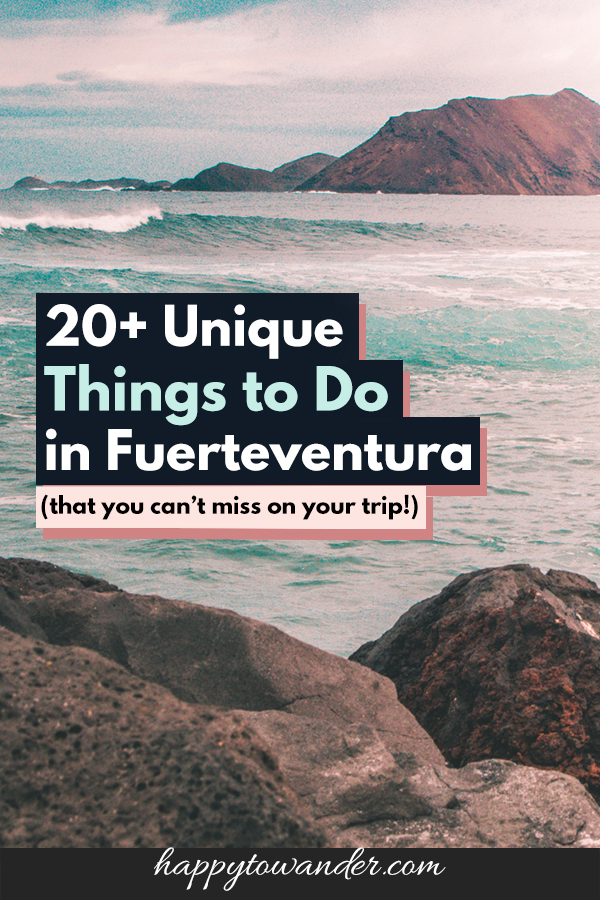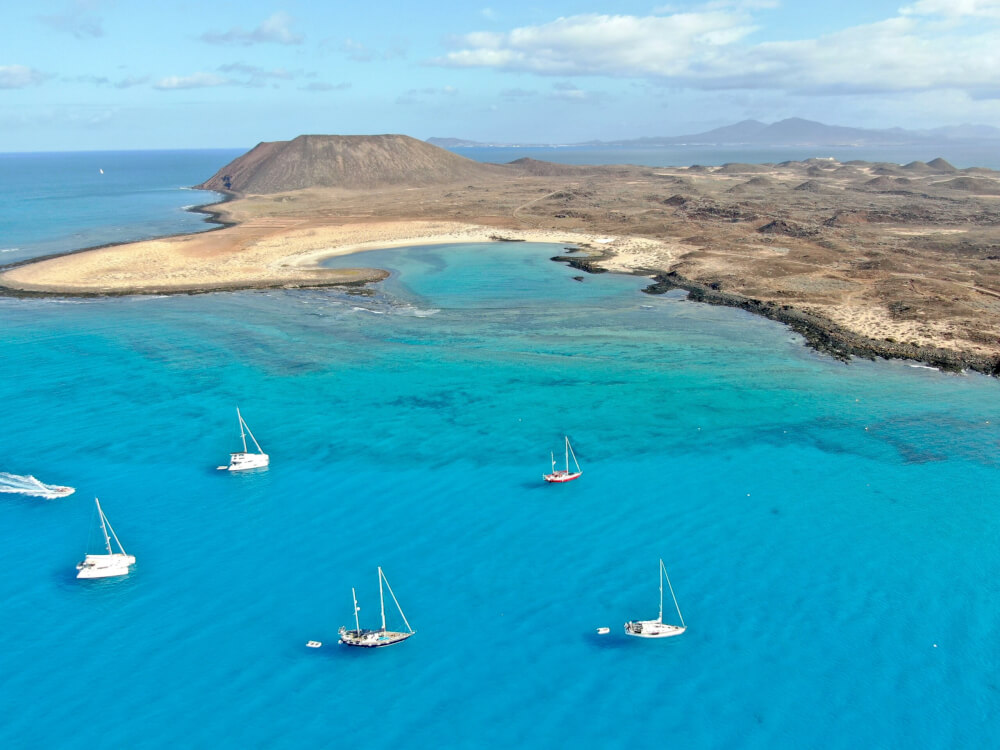*FYI - this post may contain affiliate links, which means we earn a commission at no extra cost to you if you purchase from them. Also, as an Amazon Associate I earn from qualifying purchases. Check out our Privacy Policy and Disclosure. for more info.
Serene and sun-kissed Fuerteventura is an island paradise best known for its rugged waves, sandy beaches, and diverse landscapes.
It is, however, seared forever in my memory as the place I once attempted a surf camp, and endured a lifetime of embarrassment in the process.
But my personal shame aside, there’s quite a bit to see and do in Fuerteventura, the second largest Canary Island, from breathtaking beaches and national parks to… goat hiking tours and museums dedicated to cheese and windmills.
Intrigued? I sure hope so. Read on for a list of the top must-sees in Fuerteventura.
1. Visit Corralejo Dunes National Park
We’ll start with one of the most popular things to do in Fuerteventura, and that’s a visit to the Corralejo Dunes National Park.
This mesmerizing expanse of sand dunes stretches for miles, and is a top pick for visitors from around the world for sunbathing, sandboarding, or simply enjoying the dramatic landscapes.
The park also boasts pristine beaches with turquoise waters ideal for swimming, windsurfing, and attempting in vain to surf (if you’re me). Wildlife enthusiasts can spot various bird species and unique desert flora in the more than 2,600 hectares that the park covers.
Looking for a mini challenge? A real highlight of a visit here is hiking 300 metres up the Montaña Roja (Red Mountain) volcano for epic views across the island.
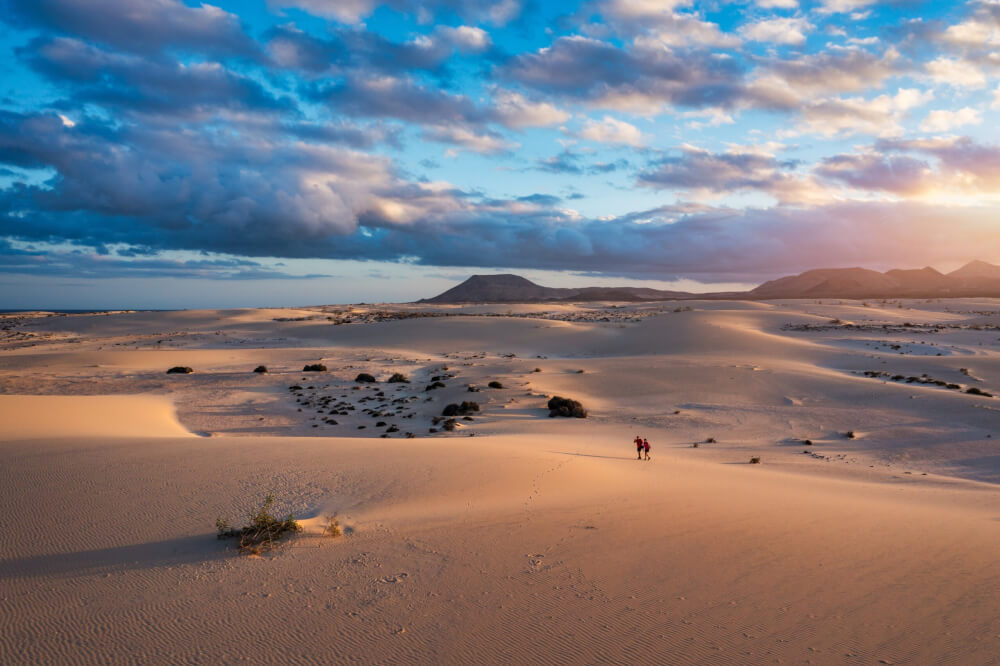
2. Relax on the beaches of Corralejo
While there’s no shortage of beaches in Fuertenveura, one area that’s especially beloved for sunbathing is Corralejo.
This is where I was based during my stay, and while my visit was marred by unseasonably rough winds, I could still appreciate its beauty as a beach destination.
Popular beaches here include…
- Playa del Moro: If you want to see the famous dunes then head here, where you can enjoy pristine white sands and crystal-clear waters that are perfect for surfing. There aren’t any amenities here though, so you’ll need to bring with you anything you need for a beach day.
- Playa de Corralejo Viejo: For a calmer water experience, this beach near the centre of town is quite sheltered so it’s perfect for those who don’t want to deal with massive waves. You can also rent sunbeds and umbrellas here if you just want to relax, plus there are lots of places to get food or drink along the waterfront.
- Playa Baja Negro: If you want to spend time at the wide open beaches but don’t want to forgo having cafés or other amenities close by then head to this beach which is next to the Hotel Riu Oliva Beach Resort. There’s public toilets and a couple of cafés that aren’t part of the resort to enjoy as well.
I will say though, Corralejo town itself is very resort-like, catering to its hordes of international visitors with tacky bars, souvenir shops and big name retailers.
If your goal is to get a feel for what typical life is like in Fuerteventura, this isn’t the place. It IS however the place for belting karaoke with German tourists at 1am, enjoying a full English breakfast in a frighteningly authentic English pub, and soaking up shameless vacation vibes through margaritas the size of your head. I’ll let you decide if that sounds up your alley!

3. Venture out to Lobos Island
From Corralejo, a beautiful and popular day trip is to Lobos Island, a small and pristine islet known for its great snorkeling and hiking. Visitors here can explore old fishing villages, go hiking or just relax on more stunning beaches.
Lobos Island is a Natural Park, Biosphere Reserve and Protection Area, so you can also see plenty of ocean life in the waters surrounding the island. You can get there by catching an affordable ferry like this one.
Or, for a more luxurious experience, you can book an adults-only catamaran day trip like this one, which includes a delicious lunch and the use of paddleboards or kayaks.
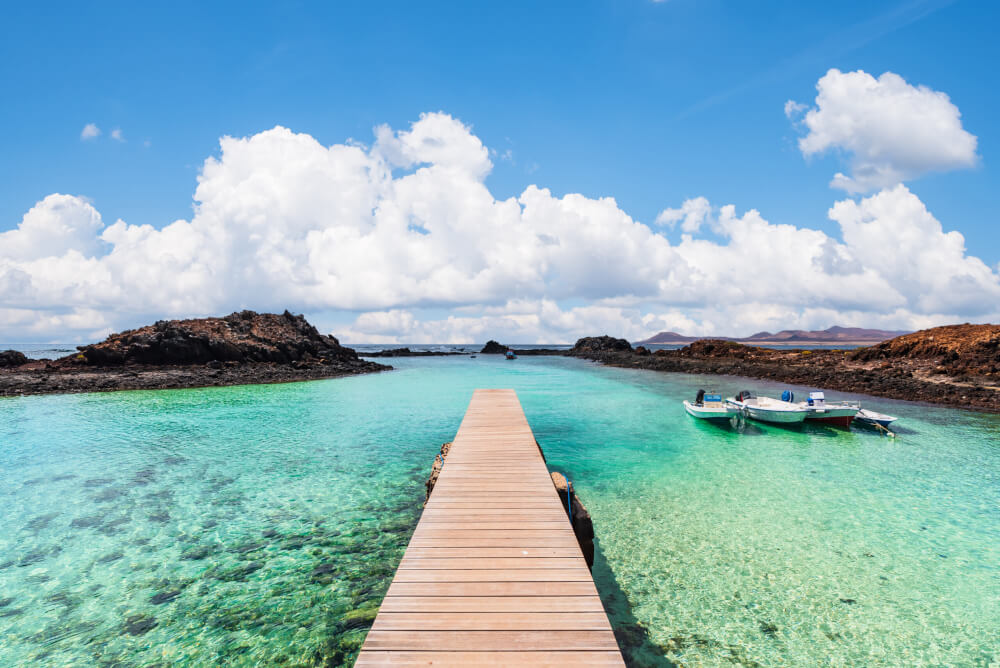
4. Visit Popcorn Beach
About a 15-minute drive (or one-hour hike) from Corralejo is a very unique beach, which is covered in white algae fossils that look like (you guessed it!) popcorn!
The Popcorn Beach, officially called Playa del Bajo de la Burra, has become very popular among photographers and social media enthusiasts, who flock to capture its eye-catching landscape. There are other beaches on Fuerteventura where these popcorn-like algae fossils can be found, although this one has the most, making it also the busiest.
Just make sure you don’t try to take any of the ‘popcorn’ home with you, as it’s an important part of the natural eco-system.

5. Join a guided food/local life tour
If there’s one complaint I had during my time in Fuerteventura, it’s that I was very much in a touristy town doing touristy things… which (don’t get me wrong) isn’t bad if your goal is to just relax on vacation.
Given that it was my first time in the Canary Islands though, I’m sad I didn’t get much time to learn much about the culture of these unique islands or what typical life looks like for its residents.
So, if that sounds like a regret you’d similarly have, then be sure to look into more cultural experiences during your time in Fuerteventura, like this tour for instance, which visits an olive tree farm and provides opportunities to taste local delicacies at a live cooking show. You’ll also get to try and even take home with you traditional treats such as cactus jam and Majorero goat cheese.
6. See Puerto del Rosario
For a less touristy town experience, be sure to schedule a visit to Puerto del Rosario, the capital of Fuerteventura.
This town is known for its white-washed houses and portside promenade, with a variety of beaches to choose from. It was originally called Puerto de Cabras (Port of the Goats) as many goats were shipped from here, but in 1957 the locals decided to change the name to Puerto del Rosario… since it sounded a bit nicer. Sorry, goats.
Highlights include…
- Centro de Arte Juan Ismael: A modern art museum named for the local artist Juan Ismael
- Nuestra Señora del Rosario: Our Lady of the Rosary Church, a fairly small but pretty church located opposite Casa Museu Miguel de Unamuno.
- Casa Museo Miguel de Unamuno: House museum of the writer Miguel de Unamuno who brought Fuerteventura to the world through his writings. You can see how he would have lived and learn more about his life and works.
- The Promenade: The main harbour area features a nice promenade to walk on, along with a quirky open-air gallery of sculptures by the Canary Islands sculptor Juan Bordes.
7. Explore the Jandia Peninsula
Known for its pristine beaches, crystal-clear waters, and laid-back atmosphere, the Jandia Peninsula is a haven in the southwestern tip of Fuerteventura popular for water sports and general beach frolicking.
Some highlights include…
- El Puertito de la Cruz: A charming white-washed fishing village that seems like it’s located at the end of the world.
- Punta Jandia Lighthouse: Just a bit further along the road from the village is this impressive lighthouse that dates from 1864 and contains a small museum on marine life. You can also climb to the observation deck for epic views.
- Morro Jable: A lovely fishing town that’s home to a Turtle Nursery that rehabilitates injured or ill turtles, as well as some nice beaches, a lighthouse and the skeleton of a sperm whale.
- Playa de Sotavento: A collection of gorgeous fine-sand beaches that stretch for over 9 km and are popular with windsurfers and kite surfers.
Looking for a more adventurous experience? You can do a buggy tour like this one!
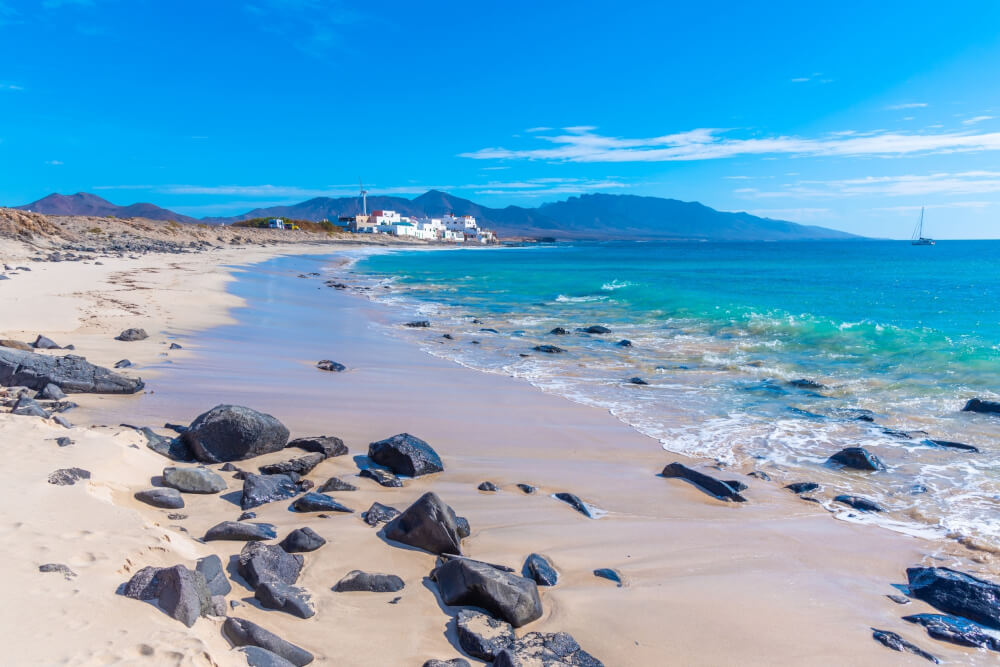
8. Check out Betancuria
Once the island’s capital, the historic town of Betancuria is a great pick for those keen to explore more of the history side of Fuerteventura.
Highlights of a visit here include…
- Fuerteventura Archaeological Museum: This small yet modern museum is fascinating, with displays about the aboriginal people of the island. It’s also free to visit!
- Museum of Sacred Art: Attached to the Santa María de Betancuria church there’s also a small museum with religious artworks on display.
- The Ruins of the Franciscan convent of San Buenaventura: On the hill overlooking the town are the remains of this beautiful old convent, which was founded in 1416 and was the first convent to be built on the Canary Islands. It makes for a particularly nice photo spot.
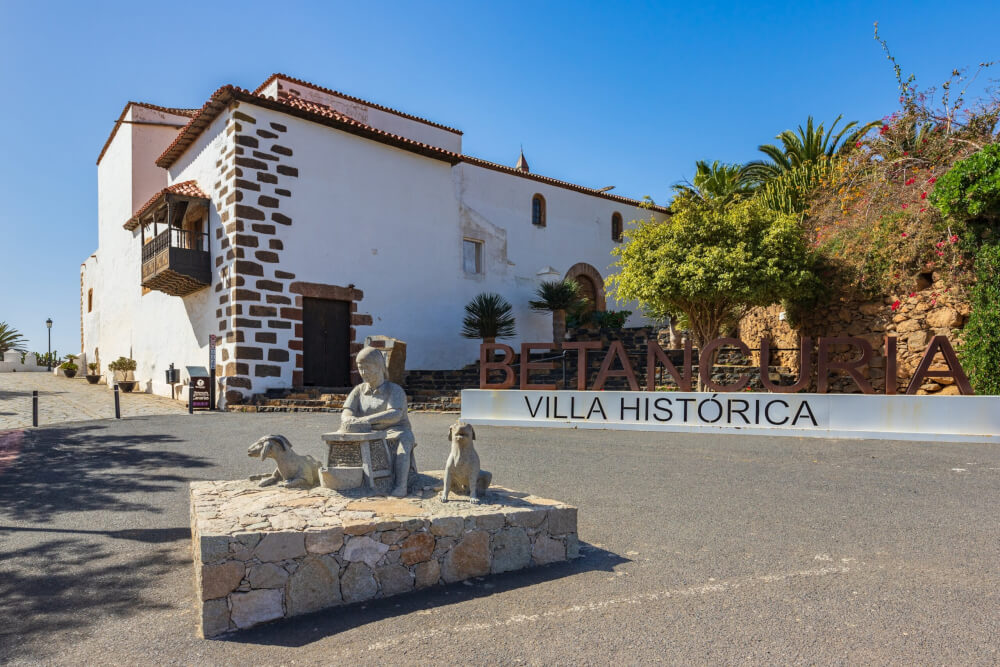
9. Cofete Beach & Villa Winter
Another Fuerteventura must-see is Cofete Beach, a hidden gem accessible via a winding mountain road. This spot is known for being one of the most wild and undeveloped parts of Fuerteventura, with 12 kilometres of unspoilt coastline to enjoy.
Overlooking this stunning landscape is Casa Winter, a villa built by German engineer Gustav Winter in 1937. Gustav Winter was known to have links to the Nazis, and it’s believed that his villa was used for parties for high-ranking officers, or as a base for German submarines. Today it’s sort of a small museum with some Nazi memorabilia, although reviews differ on how worthwhile it is to visit.
Overwhelmed by the idea of getting there yourself? You can book a tour to see it like this one.
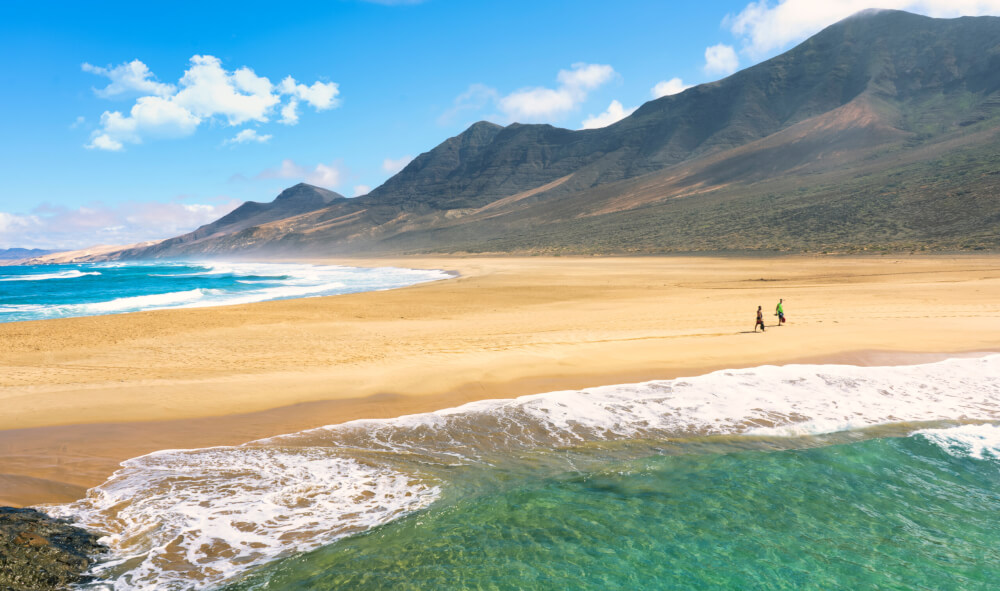
10. El Cotillo
The charming village of El Cotillo is known for its stunning beaches, including the tranquil lagoons of La Concha and the hidden coves of Los Lagos.
Other highlights include…
- El Tostón Castle: Also called Torre del Tostón, this defence tower was built in 1700 to protect the town from pirates. Nowadays there are often art exhibitions held inside.
- The Old Harbour: While Torre del Tostón overlooks the newer harbour area, the old harbour is a really pretty spot lined with whitewashed buildings housing cafés and restaurants. There are also a couple of sculptures and it’s easily one of the most picturesque parts of the town.
- Faro de Tostón: Head a little further north of town to find a classic striped lighthouse, which also houses a geology museum and provides gorgeous views.
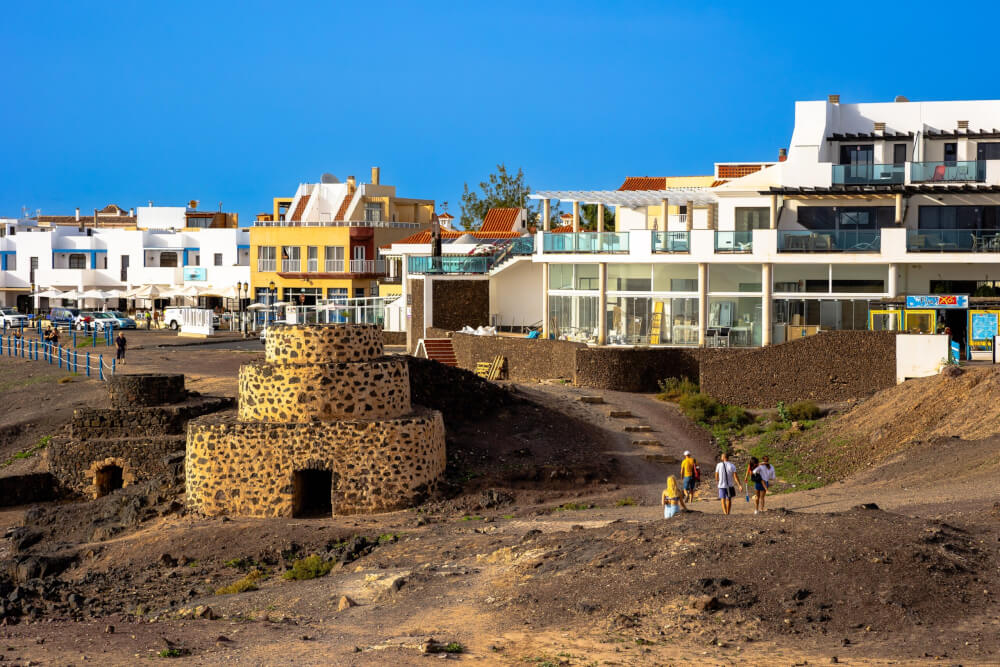
11. Visit the Ajuy Caves
Another adventurous activity in Fuerteventura is a visit to the Ajuy Caves, where lava once flowed into the sea, creating striking underground tunnels.
These days, the Ajuy Caves are among the oldest geological formations in the Canary Islands, with some rocks dating back over 100 million years.
What is there to do here? Well, a popular pick is embarking on a scenic trail that begins at the picturesque black sand beach in Ajuy and winds along the cliffs, offering stunning views of the ocean. Along the way you’ll get to see blowholes and lime kilns, before arriving at the caves proper, which are basically just open to the public at all times… though bring a jacket as it gets cool in there!
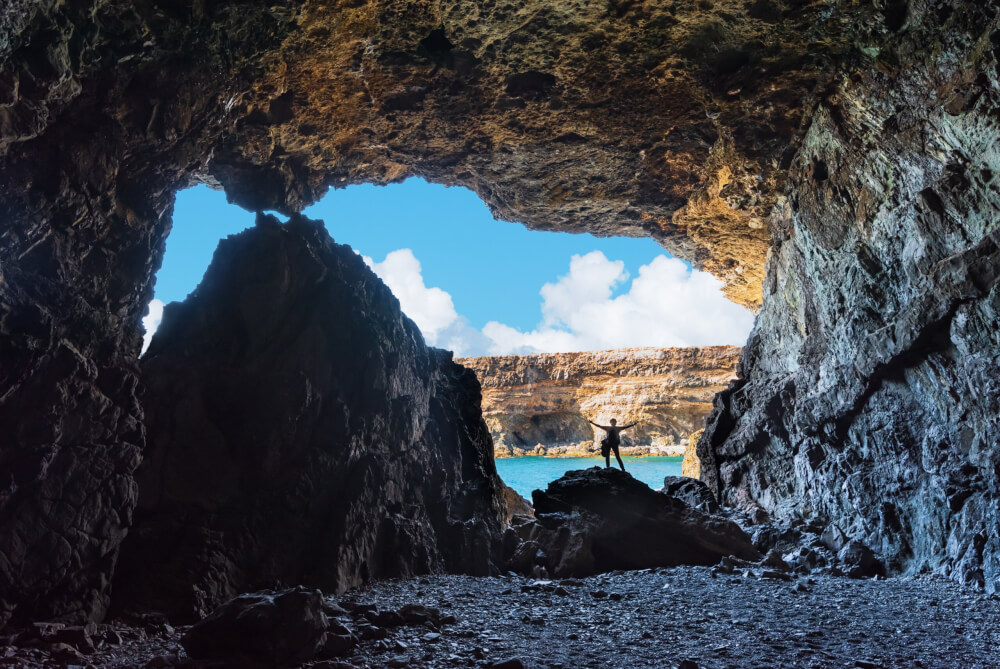
12. Go hiking with goats
No, I’m not joking. Goats are a common sight around Fuerteventura, with remains found that show there have been goats on the islands for around 3000 years.
Since Fuerteventura’s climate is so arid, goats are able to survive where other animals (like cows or sheep) cannot. There are around 30 different breeds of goats running wild on the island, along with herds kept by people who use their milk to make cheese and their meat to eat. So yes, you can pretty much see cute goats everywhere you go!
And, if you want to get up close and personal with them, you can literally book a trekking tour where they come along! This tour, for instance, includes a traditional lunch with goat’s cheese, and will see you scrambling up the local hills with an adorable pack of goats for company.
13. Hike Tindaya Mountain
Looking to hike not with goats?
Weird choice, but there’s plenty of opportunities for that too. One very popular hike is up to Tindaya Mountain, a sacred place for the indigenous Guanche people, that offers breathtaking panoramic views of the island.
Montaña Sagrada de Tindaya, as it’s also known, stands 400 metres high and really stands out in the surrounding flat landscape of Fuerteventura. There are walking trails around the base of the mountain but if you want to hike all the way to the top then (according to this website) you need to apply for a permit.
Other people have said that there’s really nothing stopping you climbing to the top aside from some signs, but as it’s designated an Area of Ecological Sensitivity, a Natural Monument and a Biosphere Reserve of Fuerteventura I would recommend you check for local guides when you’re on Fuerteventura. Other sites I found suggest that it will be open to climb again in the future (with accredited guides), so it might be worth doing a bit more research when you’ll be going there.
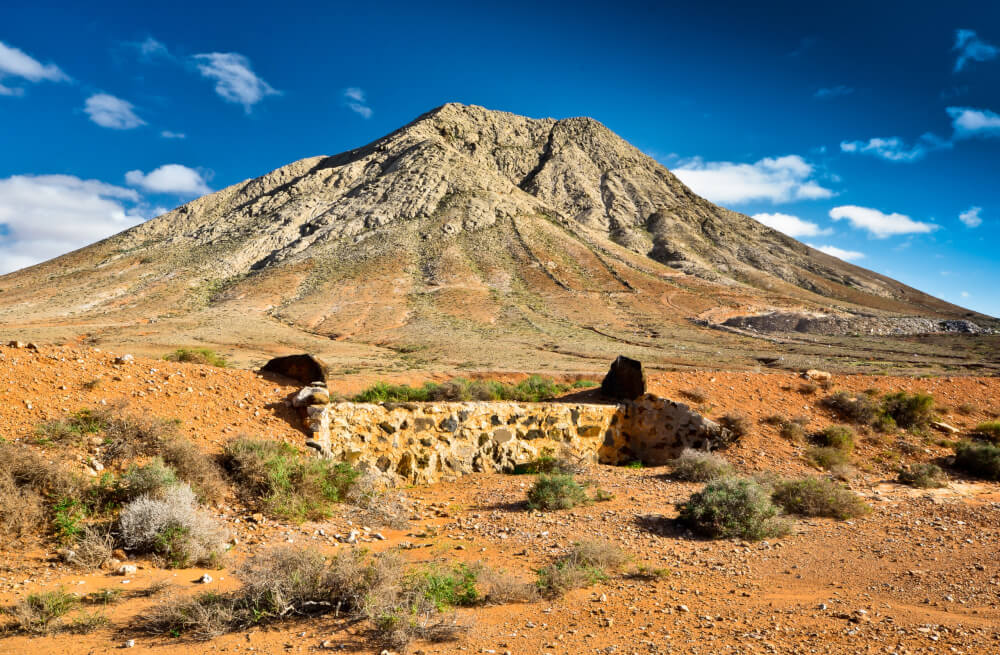
14. Mirador de Morro Velosa
For more epic sights, make sure to visit Mirador de Morro Velosa, a stunning viewpoint with a sculpture garden and incredible views of the island’s landscapes.
Located on the way to the ancient capital of the island, Bancuria, this viewpoint features a special lookout building that was designed by the Lanzarote artist César Manrique. Inside the building visitors can enjoy the views while sheltered from the winds, stop for a coffee and even check out a scale model of the whole island.
As of 2024 the road and viewpoint are currently closed, but hopefully only temporarily so that visitors can once again enjoy this spot in the future.
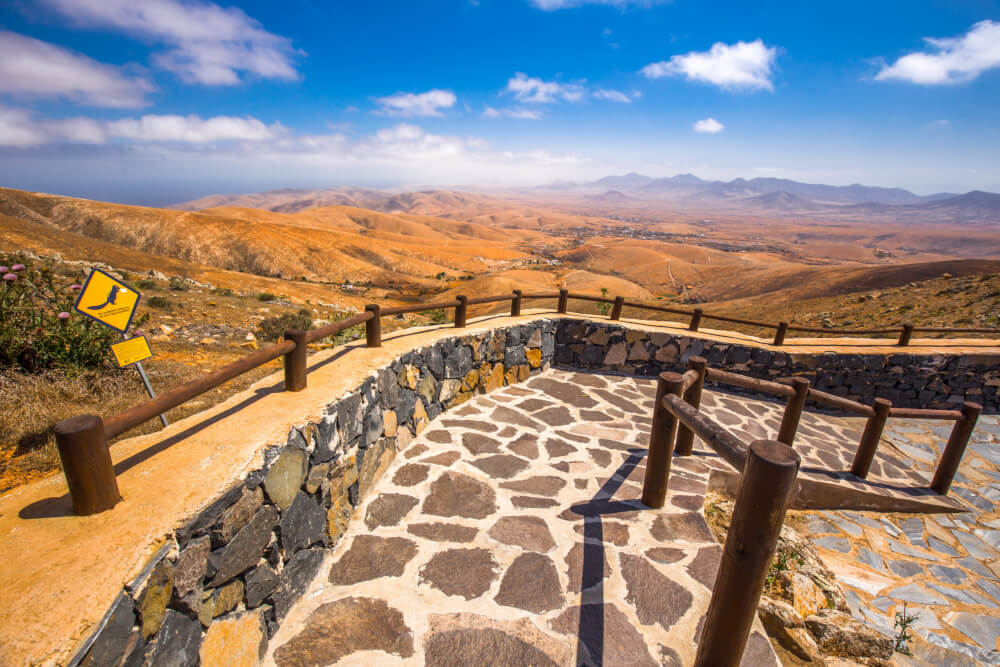
15. Hop on a sailing adventure
Fuerteventura is, of course, an island, so while you’re there you should definitely take advantage of being surrounded by water and enjoy getting out on that water for a sailing trip!
You can choose from many different sailing excursions, like this one which provides opportunities for snorkelling and possible dolphin-spotting. Other options include sailing on a handcrafted Turkish Gulet boat (lunch included) and this one even takes place on a pirate ship…
16. Try scuba diving
If you’re more interested in what’s under the waves rather than sailing up above, Fuerteventura also provides plenty of opportunities for scuba diving, thanks to its clear, warm waters and rich marine biodiversity.
Dive sites around the island feature fascinating underwater landscapes, including volcanic rock formations, caves, and vibrant coral reefs.
So where should you go? Popular spots include Lobos Island, Caleta de Fuste, and Morro Jable.
NOTE: If you don’t want to worry about bringing all your equipment with you, this scuba excursion provides everything you might need, along with an instructor to help and show you the best spots for seeing underwater life.
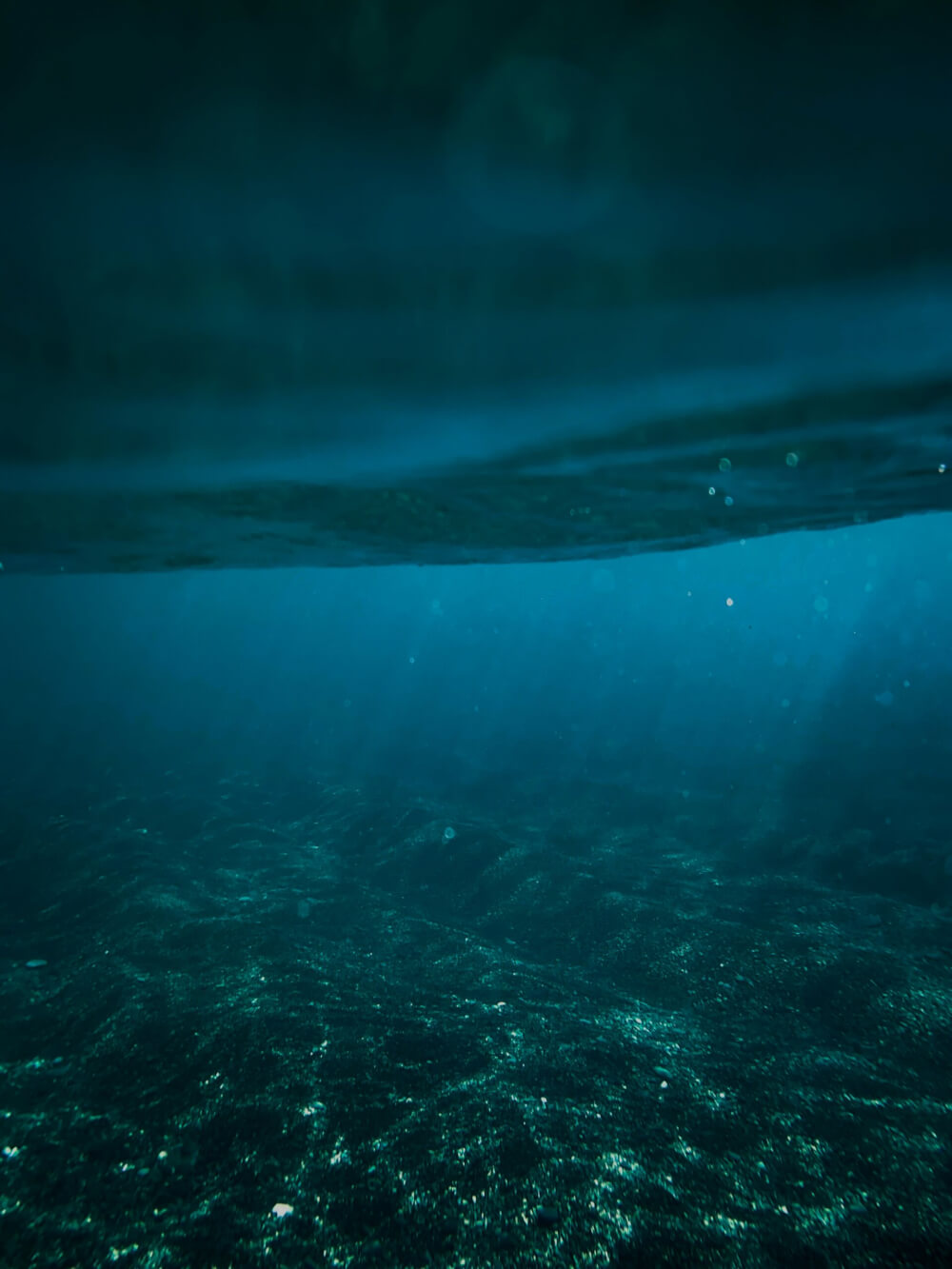
17. Windmill Museum (Molino de Antigua)
Alright, now let’s creep into the quirky museum portion of today’s Fuerteventura activities list.
While again, the island is best known for its beaches, resorts and outdoor activities, there are quite a few interesting museums to choose from.
One of them is the Windmill Museum (Molino de Antigua), a craft centre and museum built around one of the windmills that played a crucial role in the island’s history. Visitors here can learn all about how this windmill was used to mill maize, and many of the rooms have been recreated to how they looked in the 19th century, so you also feel like you’ve gone back in time.
Along with the mill/museum there’s a nice garden here with indigenous plants, a café and a gift shop. It’s also next door to the Cheese Museum, but more on that in a bit!
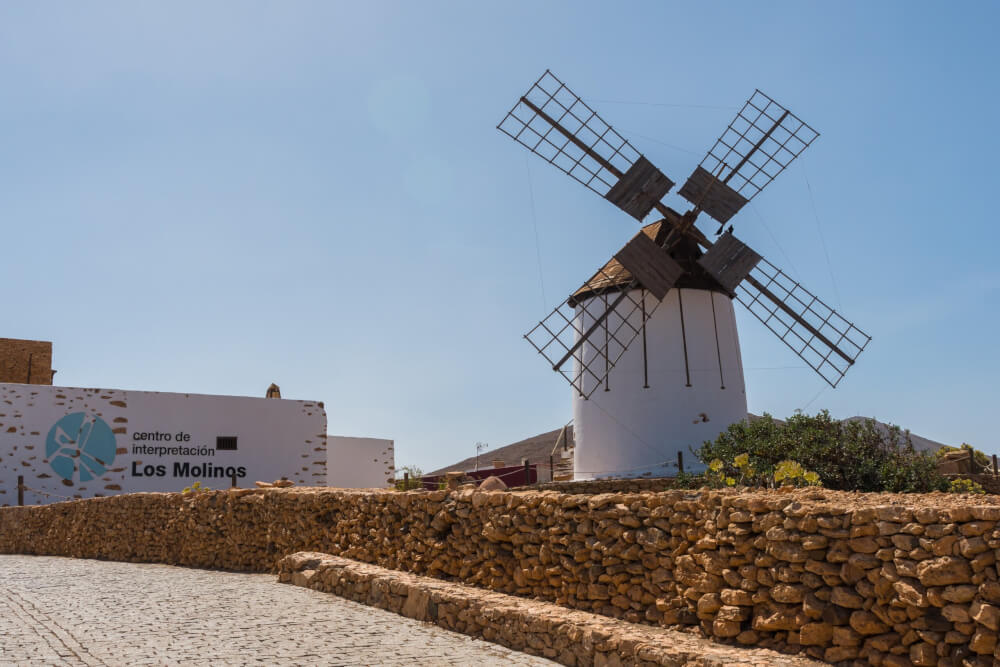
18. Salt Museum (Museo de la Sal)
Done with windmills? Why not head to the Salt Museum (Museo de la Sal) to learn about Fuerteventura’s traditional salt production methods?
Located in the picturesque area of Las Salinas del Carmen, the museum features a well-preserved saltworks, where visitors can learn about the ancient techniques used to harvest salt from the sea. Interactive exhibits and guided tours provide a comprehensive understanding of the history of salt production on the island.
And while this is a museum, it’s also still in operation so you might see people actually working in the salt pans as you wander around.

19. Visit the Cheese Museum (Museo del Queso Majorero)
Foodie visitors to Fuerteventura will definitely enjoy indulging in the flavors of the island at the Cheese Museum (Museo del Queso Majorero), where you can taste the famous Majorero cheese.
This museum is next to the windmill museum from earlier, so a visit to both makes a perfect pairing. What also makes a perfect pairing is the Majorero cheese, made from Majorero goat’s milk, with pear dishes or pasta! At this museum you’ll learn more about the local cheese-making traditions and, of course, there’s opportunities for tasting some, as well as tasty products in the shop to take home with you.
You’ll also learn more about the island’s unique environment, all about the cute Majorero goats and the history of Majorero cheese. Plus the whole place is adorable, as you can see in the photo below.
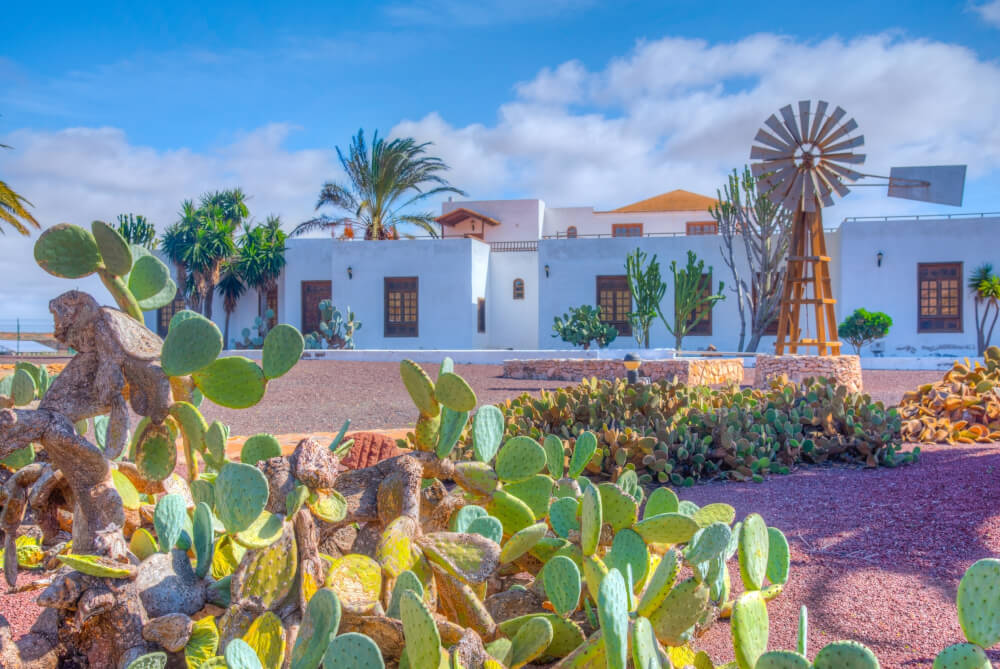
20. See the Botanical Garden of Fuerteventura
And if you enjoyed the little cactus garden at the cheese/windmill museum, make sure you also check out Fuerteventura’s Botanical Garden, which contains many unique plants only found on this island.
Spanning over 250,000 square meters, the garden features an impressive collection of cacti, succulents, and tropical plants from around the world. Visitors can explore themed sections such as the cactus garden, palm grove, and a charming bird sanctuary as the garden is technically part of the Oasis Wildlife Zoo.
For plant nerds, there are also around 15 plant species here that can only be found on Fuerteventura, and aside from one they’re all in danger of extinction. A visit here is a fun thing to do but you can also feel good that your entrance fee is helping to preserve the natural flora of the island.
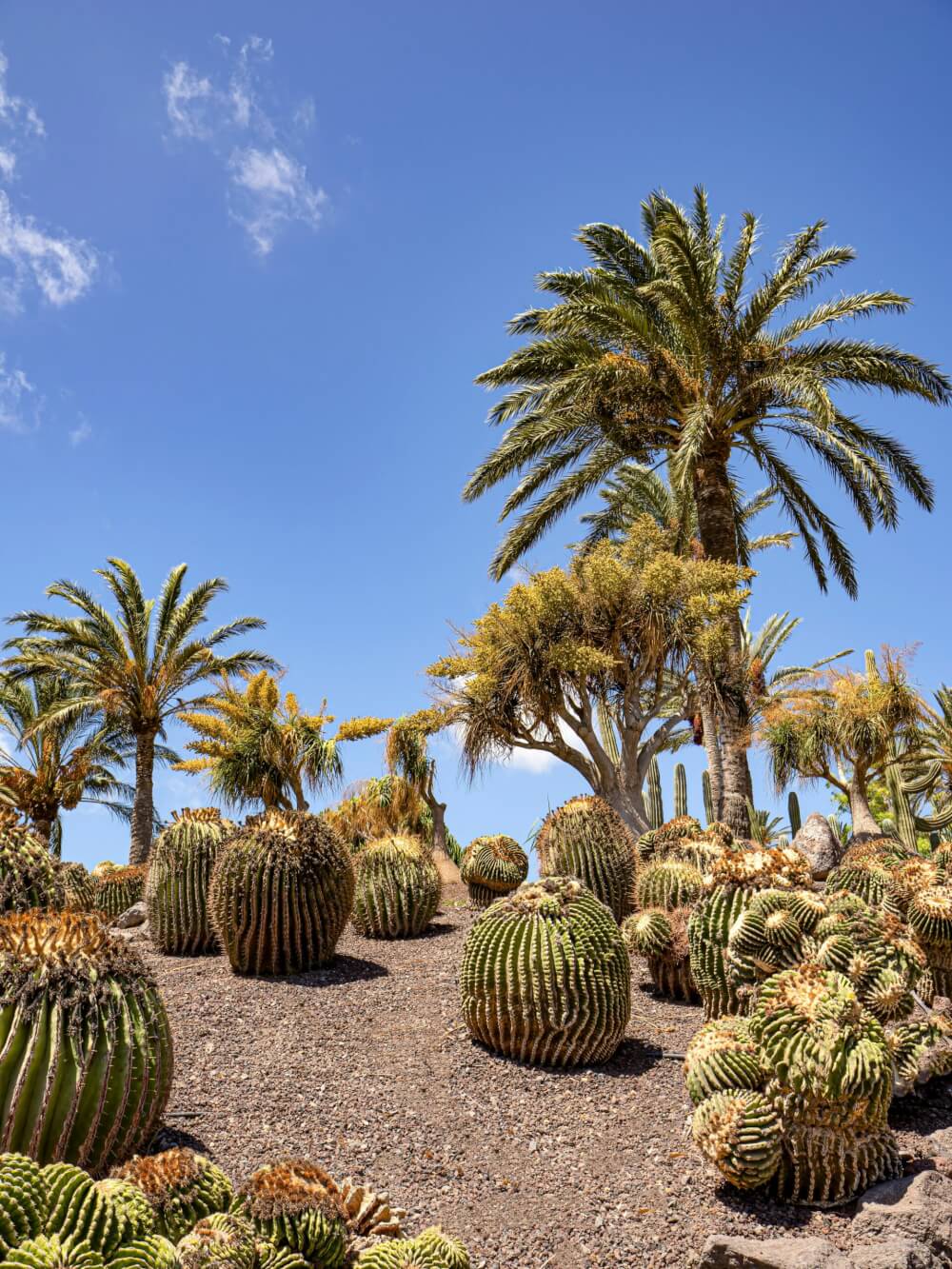
21. Take a Day trip to Lanzarote
If I can be honest, as much I enjoyed my time in Fuertenventura, the Canary Island I really fell in love with was Lanzarote.
Conveniently, Lanzarote is an easy day trip from Fuerteventura, accessible by a 28-minute boat ride.
Highlights of Lanzarote include…
- Seeing the Montanas del Fuego at Timanfaya National Park: The famous other-wordly landscapes of this national park are a must-see!
- Exploring an underground world at Cueva de los Verdes: This underground network of caves is also incredible to explore, plus it’s a nice spot to escape the heat.
- Enjoying the works of César Manrique: There are lots of places on Lanzarote to discover the works and life of this famous local artist, particularly the César Manrique House Museum.
- Wine-tasting: The black volcanic soil of Lanzarote is surprisingly great for growing grapes, so if you’re into wine then you go wine-tasting at a number of excellent vineyards, most of which are very unique as well.
You can read my full list of things to do in Lanzarote for more.
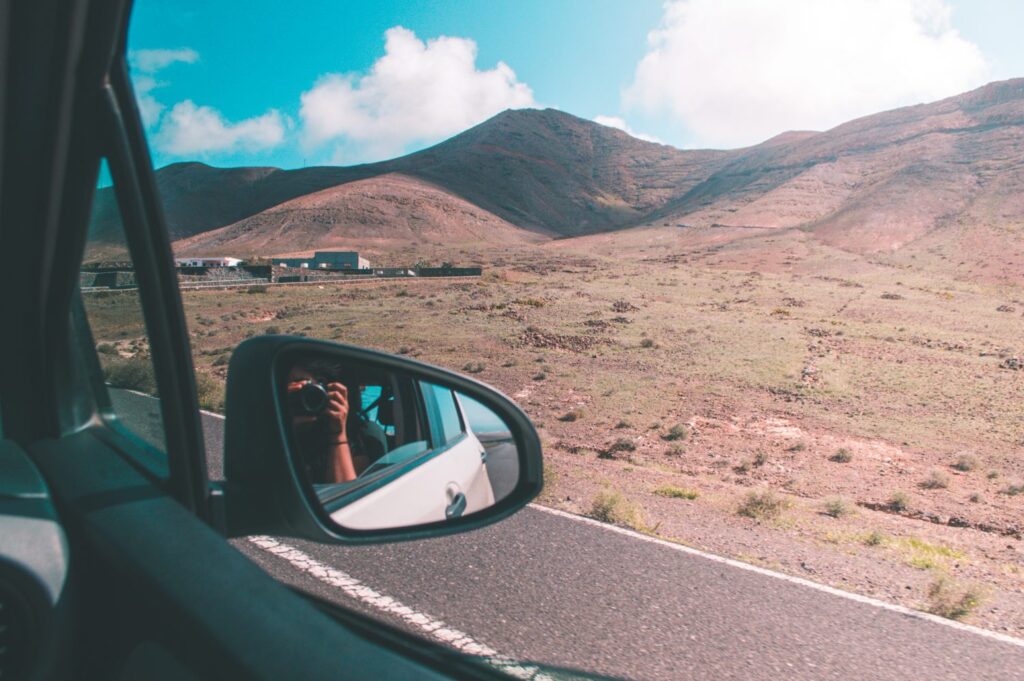
Did I miss any of your favourite things to do in Fuerteventura?
Let me know in the comments so I can add more of the best Fuerteventura activities to the list. Happy and safe travels! 🙂

